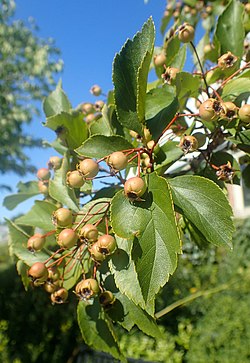| Crataegus nitida | |
|---|---|
 | |
| At the Garfield Park Conservatory in Chicago | |
| Scientific classification | |
| Kingdom: | Plantae |
| Clade: | Tracheophytes |
| Clade: | Angiosperms |
| Clade: | Eudicots |
| Clade: | Rosids |
| Order: | Rosales |
| Family: | Rosaceae |
| Genus: | Crataegus |
| Species: | C. nitida |
| Binomial name | |
| Crataegus nitida | |
Crataegus nitida, the glossy hawthorn or shining hawthorn, is a species of flowering plant in the family Rosaceae, native to the US states of Illinois, Missouri and Arkansas. [1] Hardy to USDA zone 5, it is useful in landscaping applications where a small, showy tree with thorns is desired. [2]